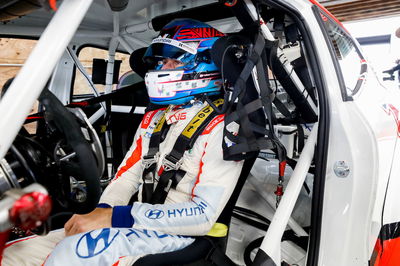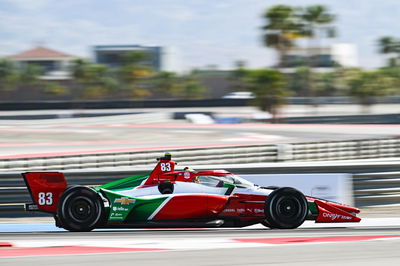Wickens to make full-time racing return in modified Hyundai

It will mark the 32-year-old Canadian’s first race action in more than three years after a life-changing IndyCar crash at Pocono in 2018 left him paralysed.
Wickens uses a wheelchair and currently walks with an assisted frame. He is unable to race using conventional pedal controls following the brutal accident.
Injuries suffered by Wickens in the crash included thoracic spinal fracture, spinal cord injury, neck fracture, tibia and fibula fractures to both legs, fractures in both hands, fractured right forearm, fractured elbow, concussion, four fractured ribs and a pulmonary contusion.
Following a lengthy period of rehabilitation, the IndyCar podium finisher and multiple DTM race-winner will return to competitive action behind the wheel of a modified Hyundai Elantra for Bryan Herta Autosport later this month at Daytona.
Wickens previously tested a Hyundai TCR car at Mid-Ohio last May and was hopeful of securing a full-time return to racing.
It has now been confirmed that he will contest a season in the North American touring car series alongside teammate Mark Wilkins in the #33 Elantra.
It’s been a long, winding, and difficult road to this point and the journey is not over, but thankful we’ll be able to move down the road with a bit more speed!
— Robert Wickens (@robertwickens) January 14, 2022
I’ll be joining @BHA for the 2022 @IMSA season and piloting one of their @hyundai Elantras.
Now, let’s go win. pic.twitter.com/hoPyoorJTO
“I’ve spent a lot of nights thinking and dreaming of this moment, and with the support from Bryan Herta and Hyundai it is all becoming a reality,” said Wickens.
“I am hungrier now than I was before my accident to compete for wins again!
“I’m really looking forward to incorporating myself with the entire Bryan Herta Autosport team and finally get my first taste of the Hyundai Elantra N TCR.”
The #33 Hyundai Elantra has been fitted with a custom hand-control system designed by BHA technical director David Brown and development Technician Jonathan Gormley. The system features a custom metal ring connected to the brake pedal by a series of rods.
The ring is located behind the steering wheel and is pulled with fingers in order to activate the brake. Two linked throttle paddles and shift paddles, also placed behind the steering wheel, allow the driver to accelerate, shift and make steering inputs.
Wilkins will deactivate the hand throttle when he takes over during the pit stops so that he can use traditional foot pedals when he is driving.
In a statement, Hyundai added that: “Wickens’ perseverance and persistence has led to triumphant breakthroughs in his relentless regimes of physical rehabilitation and therapy that continues daily.
“Wickens and his team of therapists and trainers have become trailblazers in developing innovative technology and treatment methods for the spinal cord injury community.”












